Know the Etymology: 68
Place Name of the Day: Wednesday, 05 July 2017
Kārai-tīvu/ Kārainakar, Marukkāraṅ-kuḷam, Ceṅ-kārai, Kara-gaha-vala
காரைதீவு/ காரைநகர், மருக்காரங்குளம், செங்காரை, கரக₃ஹவல
Kārai-tīvu/ Kārainakar, Marukkāraṅ-kuḷam, Ceṅ-kārai, Kara-gaha-valaKārai+tīvu
Kārai+nakar
Marukkārai+am+kuḷam
Cem+kārai
Kara+gaha+vala
The island of Kārai shrubs
The tank or pond of Marukkārai shrubs/ trees
The (place of) Ceṅkārai shrubs
The jungle or thicket of Kara shrubs
| Kārai | a low shrub with sharp axillary spines, seen in scrubby jungles and wastelands, Webera tetranda equated to Canthium parviflorum (Tamil, DED 1475, MTL, Winslow, Puṟanāṉūṟu, 258: 1); Peruṅ-kārai: a variety of Kārai; a kind of shrub with edible leaves, which are given to Brahmins with other leaves as presents or alms at the anniversary funeral ceremonies etc. (Tamil, Winslow); Randia uliginosa (Tamil, MTL); Maruk-kārai: also called Matuk-kārai: 1. a kind of Kārai, a species of common honey-thorn; 2. a small tree, emetic-nut, Randia dumetorum (Tamil, DED 4716, MTL, Winslow); Pūṅ-kārai: a shrub with fragrant flowers, Gardenia dumentorum (Tamil, Winslow); = Marukkārai, common emetic-nut (Tamil, MTL); Marak-kārai: a kind of tree (Tamil, Winslow); = Marukkārai, emetic-nut (Tamil, MTL); Maṇak-kārai: a kind of Kārai, Vangueria spinosa (Tamil, DED 4669); Kuttuk-kārai: a small species of Kārai (Tamil, Winslow); Ceṅ-kārai: a kind of Kārai, spurious honey-thorn (Tamil, MTL, Appendix); Kāra: a thorny shrub, various species names are given (Malayalam, DED 1475); Kāre: the spinous shrub, Webera tetranda (Kannada, DED 1475); Kare-mara: Randia dumetorum (Kodagu, DED 1475); Gāra: Balanites Aegyptiaca (Telugu, DED 1475); Kara: a thorny shrub, Canthium parviflorum, equated to Webera tetranda (Sinhala, Clough); Khara: hot, sharp, pungent, piercing, sharp-edged, sharp-pointed (Sinhala, Clough); hard, sharp, pungent (Sanskrit, CDIAL 3819, traced to Karkara, CDIAL 2819); Karaṭu: roughness (Tamil, DED 1265); Karu: prong, barb, spike (Tamil, DED 1265); Karukku: saw-like edge of palmyra leaf-stalk, teeth of a saw or sickle (Tamil, Malayalam, DED 1265, Kuṟuntokai, 281: 1-2); Kari-muḷ: hard thorn (Malayalam, DED 1265) |
| Kara | a thorny shrub, Canthium parviflorum, equated to Webera tetranda (Sinhala, Clough); Kārai: a low shrub with sharp axillary spines, seen in scrubby jungles and wastelands, Webera tetranda equated to Canthium parviflorum (Tamil, DED 1475, MTL, Winslow, Puṟanāṉūṟu, 258: 1); Kāra, Kāra-divayina: the island called Karadiva; "Karadiva nam divayina" (Sinhala, Sorata; Nampota, Indrapala, 2006, p. 224); Kāra-dīpa: an island noted in Akitta Jātaka; it refers to a Brahmin hermit called Akitti, a native of Kāsi, who came to Kāvērippaṭṭinaṉam and from there went to Kāradīpa, where he did penance under a Kārai tree, eating only its leaves as food (Akitta Jataka, cited by Raghavaiyangar, M., edition of his research papers, Tamil University, Tanjavur, 1984, pp. 222-223); the island is identified with Kārai-tīvu off Jaffna Peninsula. On etymology of Kara/ Kāra, see box on Kārai in Tamil |
| Marukkārai | 1. A kind of Kārai shrub, common honey-thorn, see Kārai (Tamil, MTL citing Winslow); 2. A small tree of the kind of Kārai, emetic-nut, Randia dumetorum (Tamil, DED 4716, MTL, Winslow); Matuk-kārai, Pūṅ-kārai, Marak-kārai: = Maruk-kārai (Tamil, MTL); Maṇak-kārai: Vangueria spinosa (Tamil, DED 4669); Maṅgāre: Vangueria spinosa (Kannada, DED 4669); Maṅgāre-muḷḷu: Randia dumetorum (Kannada, DED 4716). See box on Kārai |
| Ceṅkārai | a kind of Kārai, spurious honey-thorn (Tamil, MTL, Appendix); Cem+kārai; Cem: redness (Tamil, DED 1931). See box on Kārai |
| Tīvu | island (Tamil). See column 32 |
| Kuḷam | tank, pond (Tamil). See column 18 |
| Vala | forest, jungle (Sinhala, Clough); Vallai: extensive thicket, big forest (Tamil, DED 5289). See column 40 |
Kārai is a thorny shrub, commonly found in the arid wastelands of southern South Asia. The usage of the term in Tamil is seen in Caṅkam literature, inscriptions and in toponyms. Kāraik-kāl, Kāraik-kuṭi and Kārak-kāṭu are some examples seen in Tamil Nadu.
Apart from Kārai in general, two of its varieties Maruk-kārai and Ceṅ-kārai also could be seen in Eezham Tamil place names.
Kārai has cognates in Malayalam, Kannada, Kodagu, Telugu and Sinhala. The etymology of the term seems to be related to the thorns of the shrub (see box).
Karai shrub has ritualistic significance. Twigs of the shrub are offered along with Mucuṭṭai (Ipomaea candicans) and Piraṇṭai (Vitis quadrangularis) to the priest officiating annual remembrance of ancestors.
The leaves of the shrub are edible and the salad made from them is called Kāraic-campal.
* * *Kārai as a thorny shrub:"முட் கால் காரை முது பழன் ஏய்ப்பத் தெறிப்ப விளைந்த தீம் கந்தாரம்" (புறநானூறு, 258: 1-2)
"Muṭ kāl kārai mutu paḻaṉ ēyppat teṟippa viḷainta tīm kantāram" (Puṟanāṉūṟu, 258: 1-2)
The sweet matured wine, like the ripe fruit of the thorn-stemmed Kārai
Kārai as a wasteland shrub:"எட்டி இலவம் ஈகை சூரை காரை படர்ந்தெங்கும் சுட்ட சுடலை" (காரைக்கால் அம்மையார், 2: 1: 1-2)
"Eṭṭi ilavam īkai cūrai kārai paṭarnteṅkum cuṭṭa cuṭalai" (Kāraikkāl Ammaiyār, 2: 1: 1-2)
The cremation ground, found with trees and shrubs such as Eṭṭi (Strychnos nux-vomica), Ilavu (Bombax malabaricum), Īkai (species of Mimosa), Cūrai (Zizyphus oenoplia) and Kārai (Webera tetranda), spread everywhere
Kārai as a fence-shrub:"இவ் எல்லையிற் காரையோடு நின்ற புற்றே யுற்று" (Tamil inscription, 1018 CE, SII, iii, 205)
"Iv ellaiyiṟ kāraiyōṭu niṉṟa puṟṟē yuṟṟu" (Tamil inscription, 1018 CE, SII, iii, 205)
The Kārai shrub and anthill standing by it only, mark this boundary
* * *The name Kārai-tīvu for an island off Jaffna is perhaps one of the earliest literature-attested toponyms in Ilaṅkai, if this is the island noted in Akitta Jātaka (see box on Kara). This island had settlements since megalithic times.
* * *Kārai-tīvu, renamed as Kārainakar in early 20th century, is an island of its own division (Karainagar), in Jaffna district. Kāraitīvu is also the name of a largely uninhabited island off Kaṟpiṭṭi Peninsula in the Puttalam district and its corresponding coastal point in Vaṇṇāttivillu division of Puttalam district (Kalpitti OIS and Kuthiraimalai OIS); the name of a small islet or sandbank between Iṟuppiṭṭi and Ūra-tīvu, adjacent to Puṇkuṭutīvu Island in Kayts division of Jaffna district (Delft OIS); name of a point projecting in the lagoon north of Nāvitaṉveḷi in the Navithanveli division of Amparai district (Kalmunai OIS) and the name of a largely water-surrounded coastal place in the division of its own name, Karaitheevu, in Amparai district.
Marukāraṅ-kuḷam is a small tank and place southeast of Kuccaveḷi in Kuchchaveli division of Trincomalee district (Padaviya OIS)
Ceṅkārai is noted as a place name in the then Kiḻakkumūlai Vaṭakku division (part of today's Vavuniya district) of Vaṉṉi in the British records of 1819-1839 (Aruna Selladurai, p. 104)
Kara-gaha-vala is a place in Angunakolapelessa division of Hambantota district.
* * *Some related place names:Kārai:Kārait-tū: Taṉaṅkiḷappu, Thenmaradchi, Jaffna (K. Almanac, 2016-17, p. 92). Tū: water-surrounded place
Kāraiyaṭi: Kārai+aṭi: Vadamaradchi Southwest, Jaffna (Balasundaram, p. 381). Aṭi: locality
Kāraiyaṭik-kuḷam: Kārai+aṭi+kuḷam (Mantai OIS); (Kalmunai OIS)
Kāraikkāl: Nallur, Jaffna. Kāl: canal. This place may have named after Kāraikkāl in Tamil Nadu, like another place Tirunelvēli in Jaffna.
Kārai-muṉai: the tip of the Kaṟpiṭṭi Peninsula, Puttalam, (Kalpitti OIS). Muṉai: point
Kāraik-kūṭal: a locality in Puttūr, Valikamam East, Jaffna, (V. Almanac, 2013-14, p. 97). Kūṭal: assemblage
Kārai-mōṭṭai-kuḷam: near Muṭavaṉkēṇi, Katiraveḷi (Katiraveli OIS). Kuḷam was added to Mōṭṭai
Kārai-veṭṭi-vempu: Between Kuruntaṉkuịal and Iluppaikkaṭavai, (Mantai OIS). Veṭṭi: wasteland, open place; Vempu: barren land
Kārai-mōṭṭai: Iluppaikkaṭavai, (Mantai OIS). Mōṭṭai: natural pond
Kāraik-kalaṭṭi: a locality in Tumpaḷai, Vadamaradchi Northeast, Jaffna, (Balasundaram, p. 57). Kalaṭṭi: stony ground
Karaveṭṭiyāṉ-kuḷam: east of Ciṉṉattampaṉai, Vavuniya district (Vavuniya OIS). Kuḷam: tank; see Kārai-veṭṭi-vempu
* * *Kara: (Sinhala. In some hill-country place names it may mean Talipot palm)
Kara-gaha-muṇa: Mahara, Gampaha. Muṇa: from Muhuṇu: side, direction (Sorata); Muna: end, top, extremity, tip, point (Clough)
Kara-gas-kaḍa: Deltota, Kandy. Kaḍa: 1. Forest; 2. A piece of land
Kara-gaha-hinna: Ukuwela, Matale. Hinna: range
Kara-gas-talāva: Kothmale, Nuwara Eliya; Imbulpe, Ratnapura. Talāva: open glade or meadow
Kara-gaha-yaṭa-tẹnna: Kothmale, Nuwara Eliya. Yaṭa: lower; Tẹnna: high plain
Kara-gas-vẹva: Wariyapola, Kurunegala. Vẹva: tank
Kara-gaha-gedara: Panduwasnuwara West, Kurunegala; Kuliyapitiya East, Kurunegala. Gedara: house
Kara-gaha-vẹva: Thalawa, Anuradhapura. Vẹva: tank
Kara-pola: Welikanda, Polonnaruwa. Pola: place
Kara-gaha-ulpata: Uva Paranagama, Badulla. Ulpata: spring
Kara-gas-tẹnna: Welimada, Badulla. Tẹnna: high plain
Kara-gaha-vela: Bandarawela, Badulla; Bibile, Moneragala. Vela: paddy field
* * *Marukkārai:Marukkāram-paḻai: Vavuniya, Vuvuniya. Paḻai: pond, see column 63
Marukkārai-mōṭṭai: Oddusuddan, Mullaiththeevu. Mōṭṭai: natural pond, see columns 57 and 96
* * *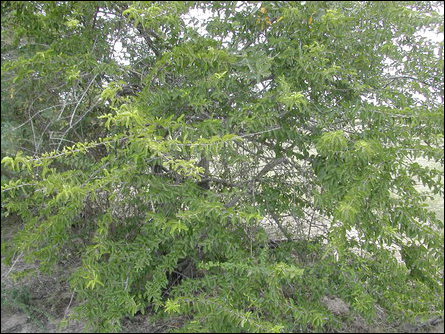
The Kaarai shrub (Webera tetrandra): Photographed in Vanni [Photo: TamilNet]
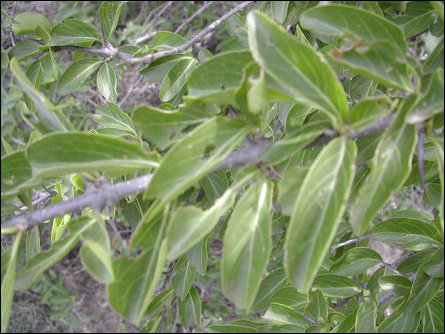
Kaarai (Webera tetrandra): Close-up of foliage. [Photo: TamilNet]
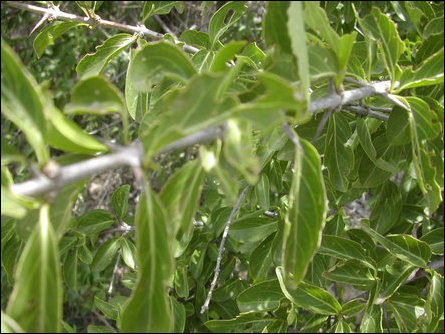
Kaarai (Webera tetrandra): Foliage (note the thorns) [Photo: TamilNet]
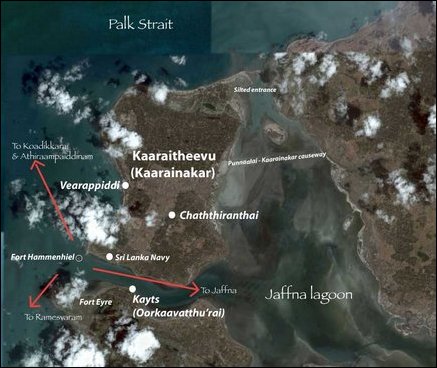
The location of Kaaraitheevu [Satellite image: Earth Google. Legend by TamilNet]
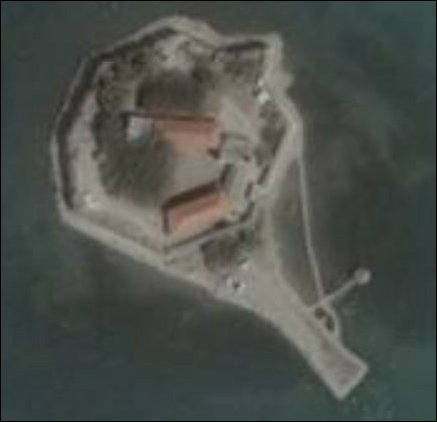
Fort Hammenhiel [Satellite image: Google Earth]
Previous columns:











